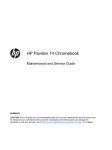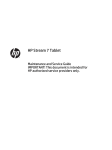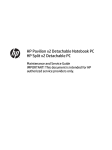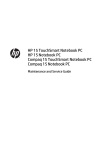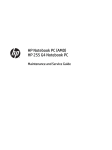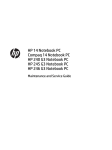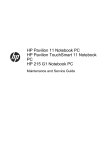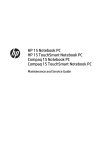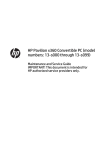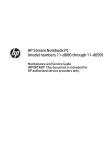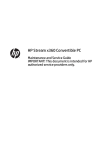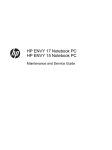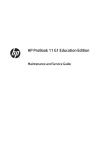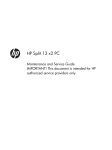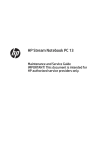Download HP 14 Notebook PC
Transcript
HP 14 Notebook PC Maintenance and Service Guide © Copyright 2014 Hewlett-Packard Development Company, L.P. AMD and AMD Radeon are trademarks of Advanced Micro Devices, Inc. Bluetooth is a trademark owned by its proprietor and used by Hewlett-Packard Company under license. Intel, Pentium, and Core are trademarks of Intel Corporation in the U.S. and other countries. Microsoft and Windows are U.S. registered trademarks of the Microsoft group of companies. Product notice This guide describes features that are common to most models. Some features may not be available on your computer. Not all features are available in all editions of Windows 8. This computer may require upgraded and/or separately purchased hardware, drivers and/or software to take full advantage of Windows 8 functionality. See http://www.microsoft.com for details. The information contained herein is subject to change without notice. The only warranties for HP products and services are set forth in the express warranty statements accompanying such products and services. Nothing herein should be construed as constituting an additional warranty. HP shall not be liable for technical or editorial errors or omissions contained herein. First Edition: August 2014 Document Part Number: 786610-001 Important Notice about Customer Self-Repair Parts CAUTION: Your computer includes Customer Self-Repair parts and parts that should only be accessed by an authorized service provider. See Chapter 5, "Removal and replacement procedures for Customer Self-Repair parts," for details. Accessing parts described in Chapter 6, "Removal and replacement procedures for Authorized Service Provider only parts," can damage the computer or void your warranty. iii iv Important Notice about Customer Self-Repair Parts Safety warning notice WARNING! To reduce the possibility of heat-related injuries or of overheating the device, do not place the device directly on your lap or obstruct the device air vents. Use the device only on a hard, flat surface. Do not allow another hard surface, such as an adjoining optional printer, or a soft surface, such as pillows or rugs or clothing, to block airflow. Also, do not allow the AC adapter to contact the skin or a soft surface, such as pillows or rugs or clothing, during operation. The device and the AC adapter comply with the user-accessible surface temperature limits defined by the International Standard for Safety of Information Technology Equipment (IEC 60950). v vi Safety warning notice Table of contents 1 Product description ....................................................................................................................................... 1 2 External component identification ................................................................................................................. 3 Right side ............................................................................................................................................................... 3 Left side ................................................................................................................................................................. 4 Display ................................................................................................................................................................... 5 Top ......................................................................................................................................................................... 6 TouchPad ............................................................................................................................................. 6 Lights ................................................................................................................................................... 7 Buttons and speakers ......................................................................................................................... 8 Keys ..................................................................................................................................................... 9 Bottom ................................................................................................................................................................. 10 Labels ................................................................................................................................................................... 11 3 Illustrated parts catalog .............................................................................................................................. 13 Computer major components ............................................................................................................................. 13 Mass storage devices .......................................................................................................................................... 15 Display assembly subcomponents ..................................................................................................................... 16 Miscellaneous parts ............................................................................................................................................. 17 Sequential part number listing ........................................................................................................................... 17 4 Removal and replacement procedures preliminary requirements .................................................................... 19 Tools required ...................................................................................................................................................... 19 Service considerations ........................................................................................................................................ 19 Plastic parts ....................................................................................................................................... 19 Cables and connectors ...................................................................................................................... 20 Drive handling ................................................................................................................................... 20 Grounding guidelines ........................................................................................................................................... 21 Electrostatic discharge damage ....................................................................................................... 21 Packaging and transporting guidelines ......................................................................... 22 Workstation guidelines ................................................................................................... 22 Equipment guidelines ..................................................................................................... 23 5 Removal and replacement procedures for Customer Self-Repair parts ............................................................. 24 Component replacement procedures ................................................................................................................. 24 Battery ............................................................................................................................................... 25 vii Service door ....................................................................................................................................... 26 Memory module ................................................................................................................................ 28 WLAN module .................................................................................................................................... 30 Optical drive ...................................................................................................................................... 32 Keyboard ........................................................................................................................................... 34 6 Removal and replacement procedures for Authorized Service Provider parts ................................................... 37 Component replacement procedures ................................................................................................................. 37 Display panel ..................................................................................................................................... 38 Top cover ........................................................................................................................................... 41 Hard drive .......................................................................................................................................... 44 Power button board .......................................................................................................................... 47 TouchPad button board .................................................................................................................... 49 Optical drive connector cable ........................................................................................................... 50 System board .................................................................................................................................... 52 RTC battery ........................................................................................................................................ 56 Fan ..................................................................................................................................................... 58 Heat sink assembly ........................................................................................................................... 60 Power connector cable ...................................................................................................................... 62 Speakers ............................................................................................................................................ 63 Display assembly subcomponents ................................................................................................... 66 7 Using Setup Utility (BIOS) ............................................................................................................................. 72 Starting Setup Utility (BIOS) ................................................................................................................................ 72 Updating the BIOS ................................................................................................................................................ 72 Determining the BIOS version ........................................................................................................... 72 Downloading a BIOS update .............................................................................................................. 73 8 Using HP PC Hardware Diagnostics (UEFI) ...................................................................................................... 74 Downloading HP PC Hardware Diagnostics (UEFI) to a USB device .................................................................... 74 9 Backing up, restoring, and recovering ........................................................................................................... 75 Creating recovery media and backups (select models only) .............................................................................. 75 Creating HP Recovery media (select models only) ........................................................................... 75 Using Windows tools ......................................................................................................................... 76 Restore and recover (select models only) .......................................................................................................... 76 Recovering using HP Recovery Manager (select models only) ........................................................ 77 What you need to know .................................................................................................. 77 Using the HP Recovery partition (select models only) .................................................. 77 Using HP Recovery media to recover ............................................................................. 78 viii Changing the computer boot order ................................................................................ 78 10 Specifications ........................................................................................................................................... 79 Computer specifications ...................................................................................................................................... 79 Display specifications .......................................................................................................................................... 80 Hard drive specifications ..................................................................................................................................... 81 DVD±RW SuperMulti Double-Layer Combination Drive specifications .............................................................. 82 11 Power cord set requirements ...................................................................................................................... 83 Requirements for all countries ........................................................................................................................... 83 Requirements for specific countries and regions ............................................................................................... 84 12 Recycling .................................................................................................................................................. 86 Index ............................................................................................................................................................. 87 ix x 1 Product description Category Description Product Name HP 14 Notebook PC Processors Processors are attached to the system board. AMD A4-PRO 3340B (2.2 GHz, 2 MB L2, 1600 MHz DDR3L), quad core, 25 W AMD A4-5000 (1.5 GHz, 2 MB L2, 1600 MHz DDR3L), quad core, 15 W AMD E1-2100 (1.0 GHz, 1 MB L2, 1333 MHz DDR3L), dual core, 9 W Chipset AMD Integrated SOC FCH Graphics Internal graphics: ● AMD Radeon HD 8330, for use with computer models with A4 processors ● AMD Radeon HD 8210, for use with computer models with E1 processors HD decode, DX11.1, and HDMI Panel 14 in (35.56 cm), high-definition (HD), white light-emitting diode (WLED), BrightView (1366×768) flat display, 3.6 mm, SVA, typical brightness: 200 nits 16:9 Ultra Wide Aspect Ratio Single channel LVDS support Memory Two SODIMM customer-accessible/upgradable memory module slots DDR3L-1600 MHz single channel support Supports up to 4 GB in the following configurations: Hard drive ● 4096 MB (4096 MB×1) ● 2048 MB (2048 MB×1) Supports 6.35 cm (2.5 in) hard drives in 9.5 mm (.37 in) and 7.0 mm (.28 in) thicknesses (all hard drives use the same bracket): ● 1 TB, 5400 rpm, 9.5 mm ● 500 GB, 5400 rpm, 7.0 mm/9.5 mm ● 320 GB, 5400 rpm, 7.0 mm Accelerometer/HP protection support Optical drive DVD±RW Double-Layer SuperMulti Drive 9.5 mm tray load, fixed, serial ATA Zero power optical drive Audio and video HD Audio Dual speakers HP Webcam (VGA camera, fixed (no tilt) with activity LED; 640×480 by 24 frames per second Single digital microphone Ethernet Integrated 10/100 NIC 1 Category Description Wireless Integrated wireless local area network (WLAN) options with single antenna (HMC/PCIe) Compatible with Miracast-certified devices Support for the following WLAN formats: External media cards Ports ● Realtek RT8723BE 802.11bgn 1x1 Wi-Fi + BT4.0 Combo Adapter ● Realtek RTL8188EE 802.11 bgn 1x1 Wi-Fi adapter HP Multi-Format Memory Card Reader slot with push-push technology, supporting the following digital card formats: ● Secure Digital (SD) Memory Card ● Secure Digital High Capacity (SDHC) Memory Card ● Secure Digital eXtended Capacity (SDXC) Memory Card AC Smart Pin adapter plug (4.5 mm barrel) Combination audio-out (stereo headphone)/audio-in (mono microphone) RJ-45 (Ethernet) USB 3.0 (2 ports), USB 2.0 (1 port) HDMI version 1.4 output supporting 1920 x 1080 @ 60 Hz (1) USB 2.0 port (right side) (2) USB 3.0 ports (left side) Keyboard/ pointing devices Full-size black textured island-style, with black keyboard frame Multitouch gestures enabled (2-finger scroll, pinch/zoom, edge swipe) Supports Windows® 8 Modern Trackpad Gestures Supports PS/2 interface Power requirements 45 W AC adapter (4.5 mm) 1 meter power cord Supports the following batteries: ● 4 cell battery - 41 Whr (2.8 AH) ● 3 cell battery - 31 Whr (2.8 AH) Supports battery fast charge, battery life enhancement 2 Security Security cable lock Operating system Windows 8.1 with Bing image (64 bit) Serviceability End-user replaceable parts: ● AC adapter ● Battery ● Keyboard ● Memory module ● Optical drive ● WLAN module Chapter 1 Product description 2 External component identification Right side Component (1) Description Power light ● On: The computer is on. ● Blinking: The computer is in the Sleep state, a power-saving state. The computer shuts off power to the display and other unneeded components. ● Off: The computer is off or in Hibernation. Hibernation is a power-saving state that uses the least amount of power. NOTE: For select models, the Intel Rapid Start Technology feature is enabled at the factory. Rapid Start Technology allows your computer to resume quickly from inactivity. (2) (3) Hard drive light Audio-out (headphone) / Audio-in (microphone) jack ● Blinking white: The hard drive is being accessed. ● Amber: HP 3D DriveGuard has temporarily parked the hard drive. Connects optional powered stereo speakers, headphones, earbuds, a headset, or a television audio cable. Also connects an optional headset microphone. This jack does not support optional microphone-only devices. WARNING! To reduce the risk of personal injury, adjust the volume before using the headphones, earbuds, or a headset. For additional safety information, refer to the Regulatory, Safety and Environmental Notices. NOTE: When a device is connected to the jack, the computer speakers are disabled. NOTE: Be sure that the device cable has a 4-conductor connector that supports both audio-out (headphone) and audio-in (microphone). (4) USB 2.0 port Connects an optional USB device, such as a keyboard, mouse, external drive, printer, scanner, or USB hub. (5) Optical drive Reads and/or writes, depending on your computer model, to an optical disc. Right side 3 Component Description NOTE: For disc compatibility information, navigate to the Help and Support webpage. Follow the web page instructions to select your computer model. Select Support & Drivers, and then select Product Information. (6) Optical drive eject button Releases the disc tray. Left side Component Description (1) Power connector Connects an AC adapter. (2) AC adapter adapter/battery light ● White: The AC adapter is connected and the battery is charged. ● Amber: The AC adapter is connected and the battery is charging. ● Off: The computer is using DC power. (3) Security cable slot Attaches an optional security cable to the computer. NOTE: The security cable is designed to act as a deterrent, but it may not prevent the computer from being mishandled or stolen. (4) RJ-45 (network) jack Connects a network cable. RJ-45 (network) status lights (2) White: The network is connected. Amber: Activity is occurring on the network. (5) Vents (2) Enable airflow to cool internal components. NOTE: The computer fan starts up automatically to cool internal components and prevent overheating. It is normal for the internal fan to cycle on and off during routine operation. (6) HDMI port Connects an optional video or audio device, such as a highdefinition television, any compatible digital or audio component, or a high-speed HDMI device. (7) USB 3.0 ports (2) Connect optional USB device, such as a keyboard, mouse, external drive, printer, scanner or USB hub. (8) Memory card reader Reads data from and writes data to memory cards such as Secure Digital (SD). To insert: 4 Chapter 2 External component identification Component Description ▲ Hold the card, label side up, with connectors facing the slot and push in the card until it is firmly seated. To remove: ▲ Press in on the card and quickly release it until it pops out. Display Component Description (1) Send and receive wireless signals to communicate with wireless local area networks (WLANs). WLAN antennas (2)* NOTE: To set up a WLAN and connect to the Internet, you need a broadband modem (either DSL or cable) (purchased separately), high-speed internet service purchased from an Internet service provider, and a wireless router (purchased separately). (2) Internal microphones (2) Record sound. (3) Webcam light On: The webcam is in use. (4) Webcam Records video and captures photographs. Some models may allow you to video conference and chat online using streaming video. *The antennas are not visible from the outside of the computer. For optimal transmission, keep the areas immediately around the antennas free from obstructions. For wireless regulatory notices, see the section of the Regulatory, Safety, and Environmental Notices that applies to your country or region. Display 5 Top TouchPad Component (1) Description TouchPad zone Moves the on-screen pointer and selects or activates items on the screen. NOTE: 6 The TouchPad also supports edge-swipe gestures. (2) Left TouchPad button Functions like the left button on an external mouse. (3) Right TouchPad button Functions like the right button on an external mouse. Chapter 2 External component identification Lights Component (1) Description Power light ● On: The computer is on. ● Blinking: The computer is in the Sleep state, a powersaving state. The computer shuts off power to the display and other unneeded components. ● Off: The computer is off or in Hibernation. Hibernation is a power-saving state that uses the least amount of power. NOTE: For select models, the Intel Rapid Start Technology feature is enabled at the factory. Rapid Start Technology allows your computer to resume quickly from inactivity. (2) Caps lock light On: Caps lock is on, which switches the keys to all capital letters. (3) Mute light ● Amber: Computer sound is off. ● Off: Computer sound is on. (4) Wireless light On: An integrated wireless device, such as a wireless local area network (WLAN) device and/or a Bluetooth device, is on. NOTE: On some models, the wireless light is amber when all wireless devices are off. Top 7 Buttons and speakers Component (1) Description Power button ● When the computer is off, press the button to turn on the computer. ● When the computer is on, press the button briefly to initiate Sleep. ● When the computer is in the Sleep state, press the button briefly to exit Sleep. ● When the computer is in Hibernation, press the button briefly to exit Hibernation. CAUTION: Pressing and holding down the power button will result in the loss of unsaved information. If the computer has stopped responding and Windows shutdown procedures are ineffective, press and hold the power button down for at least 5 seconds to turn off the computer. NOTE: For select models, the Intel Rapid Start Technology feature is enabled at the factory. Rapid Start Technology allows your computer to resume quickly from inactivity. (2) 8 Speakers (2) Chapter 2 External component identification Produce sound. Keys Component Description (1) esc key Reveals system information when pressed in combination with the fn key. (2) fn key Executes frequently used system functions when pressed in combination with the esc key. (3) Windows key Returns you to the Start screen from an open app or the Windows desktop. NOTE: Pressing the Windows key again will return you to the previous screen. (4) Action keys Execute frequently used system functions. Top 9 Bottom Component Description (1) Battery lock latch Unlocks the battery. (2) Battery bay Holds the battery. (3) Battery release latch Releases the battery from the battery bay, after the battery lock latch has been released. (4) Vents (8) Enable airflow to cool internal components. NOTE: The computer fan starts up automatically to cool internal components and prevent overheating. It is normal for the internal fan to cycle on and off during routine operation. (5) Service door Provides access to the wireless LAN (WLAN) module slot and the memory module slots. CAUTION: To prevent an unresponsive system, replace the wireless module only with a wireless module authorized for use in the computer by the governmental agency that regulates wireless devices in your country or region. If you replace the module and then receive a warning message, remove the module to restore computer functionality, and then contact support through Help and Support. 10 Chapter 2 External component identification Labels The labels affixed to the computer provide information you may need when you troubleshoot system problems or travel internationally with the computer. IMPORTANT: All labels described in this section will be located in one of 3 places depending on your computer model: Affixed to the bottom of the computer, located in the battery bay, or under the service door. For help finding these locations, refer to Bottom on page 10. ● Service label—Provides important information to identify your computer. When contacting support, you will probably be asked for the serial number, and possibly for the product number or the model number. Locate these numbers before you contact support. NOTE: Your service labels will resemble one of the examples shown below. Refer to the illustration that most closely matches the service label on your computer. Component (1) Product name (2) Serial number (3) Product number (4) Warranty period (5) Model number (select models only) Component (1) Serial number (2) Product number (3) Warranty period Labels 11 Component 12 (4) Model number (select models only) (5) Revision number ● Regulatory label(s)—Provide(s) regulatory information about the computer. ● Wireless certification label(s)—Provide(s) information about optional wireless devices and the approval markings for the countries or regions in which the devices have been approved for use. Chapter 2 External component identification 3 Illustrated parts catalog Computer major components NOTE: Details about your computer, including model, serial number, product key, and length of warranty, are on the service tag at the bottom of your computer. See Labels on page 11 for details. Computer major components 13 Item Component Spare part number (1) Display assembly, 14.0 in (35.56 cm), high definition (HD), WLED, SVA BrightView not spared NOTE: (2) The display assembly is spared at the subcomponent level only. Keyboard (includes keyboard cable): Latin America 785871-161 United States 785871-001 (3) Top cover (includes TouchPad and cable): 785295-001 (4) Power button board (includes cable) 785287-001 (5) TouchPad button board (includes cable) 734418-001 (6) Power connector bracket is available with the power connector cable, spare part number 732067-001 (7) USB/audio board (includes cable) (8) Hard drive (does not include hard drive rubber bracket, hard drive connector cable, or screws): 1 TB, 5400 rpm, 9.5 mm 778192-005 500 GB, 5400 rpm, 7.0 mm 669299-005 Hard Drive Hardware Kit, includes: 740706-001 (9) Rubber bracket (10) Hard drive connector (11) System board (includes replacement thermal material): AMD A4-5000 for use in models without the Windows operating system 785293-001 AMD A4-5000 for use with Windows 8.1 Standard 785293-501 AMD E1-2100 processor for use in models without the Windows operating system 785292-001 AMD E1-2100 processor for use with Windows 8.1 Standard 785292-501 (12) Fan 732068-001 (13) RTC battery 697917-001 (14) Heat sink assembly (includes replacement thermal material): 776776-001 (15) Power connector cable (includes bracket): 732067-001 (16) Memory modules (2), (PC3L, 12800, 1600 MHz): (17) 2 GB memory module 691739-001 4 GB memory module 691740-001 WLAN module: Realtek RT8723BE 802.11bgn 1x1 Wi-Fi + BT4.0 Combo Adapter 753077-001 Realtek RTL8188EE 802.11 bgn Wi-Fi adapter 709848-001 (18) Speakers (include subwoofer, speaker cables, and rubber isolators) 734422-001 (19) Battery 4 cell, 41 Whr, 2.8 Ah, Li-ion battery 14 734417-001 Chapter 3 Illustrated parts catalog 752237-001 Item Component Spare part number 3 cell, 31 Whr, 2.8 Ah, Li-ion battery 776906-001 (20) Base enclosure (includes battery release latch mechanism, RJ45 cover, and screws) 785283-001 (21) DVD+/-RW DL SuperMulti Drive (includes bezel, bracket, and screws) 785286-001 (22) Service door 785288-001 Mass storage devices Item Component Spare part number (1) Hard drive (does not include the hard drive rubber bracket, hard drive connector cable, or screws) 1 TB, 5400 rpm, 9.5 mm 778192-005 500 GB 5400 rpm 7 mm 669299-005 Hard Drive Hardware Kit, includes: 740706-001 Hard drive rubber bracket Hard drive connector cable Hard drive screws (2) DVD+/-RW DL SuperMulti Drive (includes bezel, bracket, and screws) 785286-001 Mass storage devices 15 Display assembly subcomponents NOTE: The display assembly subcomponents are for the HP Pavilion flat display models only. TouchSmart models are spared at the display assembly only. 16 Item Component Spare part number (1) Display bezel (includes screws) 785285-001 (2) 14 in (35.56 cm), BrightView, HD, WLED, SVA flat display panel (Screws included in the screw kit, spare part number 785291-001) 785289-001 (3) Webcamera/microphone module (includes adhesive and screws) 776787-001 (4) Display panel cable (includes webcamera/microphone module cable and screws) 734407-001 (5) Antenna Kit (includes screw and Mylar tape) 788630-001 (6) Display Hinge Kit (includes left and right hinges and screws) 734408-001 (7) Display back cover (includes screws): 785282-001 Chapter 3 Illustrated parts catalog Miscellaneous parts Component Spare part number 45 W HP Smart AC adapter (nPFC, RC, 3-wire, 4.5 mm) 741727-001 Power cord (3 pin, black, 1.83 m): For use in the United States 755530-001 For use in Argentina 755530-D01 For use in India 755530-D61 For use in Italy 755530-061 Screw Kit 785291-001 Sequential part number listing Spare part number Description 669299-005 500 GB, 5400 rpm hard drive (SATA, 7.0 mm, does not include hard drive rubber bracket, hard drive connector cable, or screws) NOTE: The hard drive rubber bracket, hard drive connector cable, and screws are included in the Hard Drive Hardware Kit, spare part number 740706-001. 691739-001 2 GB memory module (PC3, 12800, 1600 MHz) 691740-001 4 GB memory module (PC3, 12800, 1600 MHz) 697917-001 RTC battery 709848-001 Realtek RTL8188EE 802.11 bgn Wi-Fi Adapter 732067-001 Power connector cable (includes bracket) 732068-001 Fan 734407-001 Display panel cable (includes (includes webcamera/microphone module cable and screws ) 734408-001 Display Hinge Kit (includes left and right hinges and screws) 734417-001 USB/audio board (includes cable) 734418-001 TouchPad button board (includes cable) 734422-001 Speakers (include subwoofer, speaker cables, and rubber isolators) 740706-001 Hard Drive Hardware Kit (includes hard drive rubber bracket, hard drive connector cable, and screws) 741727-001 45 W HP Smart AC adapter (nPFC, RC, 3-wire, 4.5 mm), nslim 752237-001 4 cell, 41 Whr, 2.8 Ah, Li-ion battery 753077-001 Realtek RT8723BE 802.11bgn 1x1 Wi-Fi + BT4.0 Combo Adapter 755530-001 Power cord for use in North America (3 pin, black, 1.83 m) 755530-061 Power cord for use in Italy (3 pin, black, 1.83 m) 755530-D01 Power cord for use in Argentina (3 pin, black, 1.83 m) Miscellaneous parts 17 Spare part number Description 755530-D61 Power cord for use in India (3 pin, black, 1.83 m) 776776-001 Heat sink for use only on computer models equipped with Intel processors and switchable discrete graphics 776787-001 Webcamera/microphone module (includes adhesive and screws) 776906-001 3 cell, 31 Whr, 2.8 Ah, Li-ion battery 778192-005 1 TB, 5400 rpm hard drive (SATA, 9.5 mm, does not include hard drive rubber bracket, hard drive connector cable, or screws) NOTE: The hard drive rubber bracket, hard drive connector cable, and screws are included in the Hard Drive Hardware Kit, spare part number 740706-001. 18 785282-001 Display back cover 785283-001 Base enclosure (includes battery release latch mechanism , RJ-45 cover, and screws) 785286-001 DVD+/-RW DL SuperMulti Drive (includes bezel, bracket, and screws) 785287-001 Power button board (includes cable) 785288-001 Service door 785289-001 14 in (35.56 cm), WLED, HD, BrightView flat display panel for use with HP Pavilion Notebooks only 785291-001 Screw Kit 785292-001 System board with AMD E1-2100 processor for use in models without the Windows operating system (includes replacement thermal material) 785292-501 System board with AMD E1-2100 processor for use in models with Windows 8.1 Standard (includes replacement thermal material) 785293-001 System board for use with computer models with an AMD A4-5000 processor and without the Windows operating system (includes replacement thermal material) 785293-501 System board for use with computer models with an AMD A4-5000 processor and Windows 8.1 Standard (includes replacement thermal material) 785295-001 Top cover (includes TouchPad and cable) 785285-001 Display bezel (includes 2 rubber screw covers and rubber bumpers), for the HP Pavilion flat display models only 785871-001 Keyboard in black finish for use in the United States (includes keyboard cable) 785871-161 Keyboard in black finish for use in Latin America (includes keyboard cable) 788630-001 Antenna Kit (includes screw and Mylar tape) Chapter 3 Illustrated parts catalog 4 Removal and replacement procedures preliminary requirements Tools required You will need the following tools to complete the removal and replacement procedures: ● Flat-bladed screwdriver ● Magnetic screwdriver ● Phillips P0 and P1 screwdrivers Service considerations The following sections include some of the considerations that you must keep in mind during disassembly and assembly procedures. NOTE: As you remove each subassembly from the computer, place the subassembly (and all accompanying screws) away from the work area to prevent damage. Plastic parts CAUTION: Using excessive force during disassembly and reassembly can damage plastic parts. Use care when handling the plastic Tools required 19 Cables and connectors CAUTION: When servicing the computer, be sure that cables are placed in their proper locations during the reassembly process. Improper cable placement can damage the computer. Cables must be handled with extreme care to avoid damage. Apply only the tension required to unseat or seat the cables during removal and insertion. Handle cables by the connector whenever possible. In all cases, avoid bending, twisting, or tearing cables. Be sure that cables are routed in such a way that they cannot be caught or snagged by parts being removed or replaced. Handle flex cables with extreme care; these cables tear easily. Drive handling CAUTION: Drives are fragile components that must be handled with care. To prevent damage to the computer, damage to a drive, or loss of information, observe these precautions: Before removing or inserting a hard drive, shut down the computer. If you are unsure whether the computer is off or in Hibernation, turn the computer on, and then shut it down through the operating system. Before handling a drive, be sure that you are discharged of static electricity. While handling a drive, avoid touching the connector. Before removing a diskette drive or optical drive, be sure that a diskette or disc is not in the drive and be sure that the optical drive tray is closed. Handle drives on surfaces covered with at least one inch of shock-proof foam. Avoid dropping drives from any height onto any surface. Avoid exposing an internal hard drive to products that have magnetic fields, such as monitors or speakers. Avoid exposing an internal hard drive to products that have magnetic fields, such as monitors or speakers. Avoid exposing a drive to temperature extremes or liquids. If a drive must be mailed, place the drive in a bubble pack mailer or other suitable form of protective packaging and label the package “FRAGILE.” 20 Chapter 4 Removal and replacement procedures preliminary requirements Grounding guidelines Electrostatic discharge damage Electronic components are sensitive to electrostatic discharge (ESD). Circuitry design and structure determine the degree of sensitivity. Networks built into many integrated circuits provide some protection, but in many cases, ESD contains enough power to alter device parameters or melt silicon junctions. A discharge of static electricity from a finger or other conductor can destroy static-sensitive devices or microcircuitry. Even if the spark is neither felt nor heard, damage may have occurred. An electronic device exposed to ESD may not be affected at all and can work perfectly throughout a normal cycle. Or the device may function normally for a while, then degrade in the internal layers, reducing its life expectancy. CAUTION: To prevent damage to the computer when you are removing or installing internal components, observe these precautions: Keep components in their electrostatic-safe containers until you are ready to install them. Before touching an electronic component, discharge static electricity by using the guidelines described in this section. Avoid touching pins, leads, and circuitry. Handle electronic components as little as possible. If you remove a component, place it in an electrostatic-safe container. The following table shows how humidity affects the electrostatic voltage levels generated by different activities. CAUTION: A product can be degraded by as little as 700 V. Typical electrostatic voltage levels Relative humidity Event 10% 40% 55% Walking across carpet 35,000 V 15,000 V 7,500 V Walking across vinyl floor 12,000 V 5,000 V 3,000 V Motions of bench worker 6,000 V 800 V 400 V Removing DIPS from plastic tube 2,000 V 700 V 400 V Removing DIPS from vinyl tray 11,500 V 4,000 V 2,000 V Removing DIPS from Styrofoam 14,500 V 5,000 V 3,500 V Removing bubble pack from PCB 26,500 V 20,000 V 7,000 V Packing PCBs in foam-lined box 21,000 V 11,000 V 5,000 V Grounding guidelines 21 Packaging and transporting guidelines Follow these grounding guidelines when packaging and transporting equipment: ● To avoid hand contact, transport products in static-safe tubes, bags, or boxes. ● Protect ESD-sensitive parts and assemblies with conductive or approved containers or packaging. ● Keep ESD-sensitive parts in their containers until the parts arrive at static-free workstations. ● Place items on a grounded surface before removing items from their containers. ● Always be properly grounded when touching a component or assembly. ● Store reusable ESD-sensitive parts from assemblies in protective packaging or nonconductive foam. ● Use transporters and conveyors made of antistatic belts and roller bushings. Be sure that mechanized equipment used for moving materials is wired to ground and that proper materials are selected to avoid static charging. When grounding is not possible, use an ionizer to dissipate electric charges. Workstation guidelines Follow these grounding workstation guidelines: 22 ● Cover the workstation with approved static-shielding material. ● Use a wrist strap connected to a properly grounded work surface and use properly grounded tools and equipment. ● Use conductive field service tools, such as cutters, screwdrivers, and vacuums. ● When fixtures must directly contact dissipative surfaces, use fixtures made only of staticsafe materials. ● Keep the work area free of nonconductive materials, such as ordinary plastic assembly aids and Styrofoam. ● Handle ESD-sensitive components, parts, and assemblies by the case or PCM laminate. Handle these items only at static-free workstations. ● Avoid contact with pins, leads, or circuitry. ● Turn off power and input signals before inserting or removing connectors or test equipment. Chapter 4 Removal and replacement procedures preliminary requirements Equipment guidelines Grounding equipment must include either a wrist strap or a foot strap at a grounded workstation. ● When seated, wear a wrist strap connected to a grounded system. Wrist straps are flexible straps with a minimum of one megohm ±10% resistance in the ground cords. To provide proper ground, wear a strap snugly against the skin at all times. On grounded mats with banana-plug connectors, use alligator clips to connect a wrist strap. ● When standing, use foot straps and a grounded floor mat. Foot straps (heel, toe, or boot straps) can be used at standing workstations and are compatible with most types of shoes or boots. On conductive floors or dissipative floor mats, use foot straps on both feet with a minimum of one megohm resistance between the operator and ground. To be effective, the conductive must be worn in contact with the skin. The following grounding equipment is recommended to prevent electrostatic damage: ● Antistatic tape ● Antistatic smocks, aprons, and sleeve protectors ● Conductive bins and other assembly or soldering aids ● Nonconductive foam ● Conductive tabletop workstations with ground cords of one megohm resistance ● Static-dissipative tables or floor mats with hard ties to the ground ● Field service kits ● Static awareness labels ● Material-handling packages ● Nonconductive plastic bags, tubes, or boxes ● Metal tote boxes ● Electrostatic voltage levels and protective materials The following table lists the shielding protection provided by antistatic bags and floor mats. Material Use Voltage protection level Antistatic plastics Bags 1,500 V Carbon-loaded plastic Floor mats 7,500 V Metallized laminate Floor mats 5,000 V Grounding guidelines 23 5 Removal and replacement procedures for Customer Self-Repair parts NOTE: The Customer Self-Repair program is not available in all locations. Installing a part not supported by the Customer Self-Repair program may void your warranty. Check your warranty to determine if Customer Self-Repair is supported in your location. Component replacement procedures NOTE: Please read and follow the procedures described here to access and replace Customer Self-Repair parts successfully. NOTE: Details about your computer, including model, serial number, product key, and length of warranty, are on the service tag at the bottom of your computer. See Labels on page 11 for details. This chapter provides removal and replacement procedures for Customer Self-Repair parts. There may be as many as five screws that must be removed, replaced, and/or loosened when servicing Customer Self-Repair parts. Make special note of each screw size and location during removal and replacement. 24 Chapter 5 Removal and replacement procedures for Customer Self-Repair parts Battery Description Spare part number 4 cell, 41 Whr, 2.8 Ah, Li-ion battery 752237-001 3 cell, 31 Whr, 2.8 Ah, Li-ion battery 776906-001 Before disassembling the computer, follow these steps: 1. Turn off the computer. If you are unsure whether the computer is off or in Hibernation, turn the computer on, and then shut it down through the operating system. 2. Disconnect the power from the computer by unplugging the power cord from the computer. 3. Disconnect all external devices from the computer. Remove the battery: 1. Position the computer upside down on a flat surface. 2. Firmly slide the battery lock latch (1) to unlock the battery and slide the battery release latch (2) to release the battery. 3. Slide the battery (3) from the middle to remove it from the computer. To insert the battery: CAUTION: Do not slant the battery as you insert it. Slide the battery in straight. 1. Holding the battery in the middle, slide the battery (1) straight into the computer until the battery release latch locks into place. Component replacement procedures 25 2. Reset the battery lock latch (2) to the locked position. Service door Description Spare part number Service door 785288-001 1. Turn off the computer. If you are unsure whether the computer is off or in Hibernation, turn the computer on, and then shut it down through the operating system. 2. Disconnect the power from the computer by unplugging the power cord from the computer. 3. Disconnect all external devices from the computer. 4. Remove the battery (see Battery on page 25). Remove the service door: 26 1. Using a small Phillips screwdriver, loosen the two captive Phillips screws (1). 2. Lift the door (2). Chapter 5 Removal and replacement procedures for Customer Self-Repair parts 3. Slide the service door (3) forward to remove. Component replacement procedures 27 Memory module Description Spare part number 4 GB memory module (PC3, 12800, 1600 MHz) 691740-001 2 GB memory module (PC3, 12800, 1600 MHz) 691739-001 NOTE: Before adding memory modules, make sure the computer has the most recent BIOS version, and update the BIOS if needed. Before removing a memory module, follow these steps: 1. Turn off the computer. If you are unsure whether the computer is off or in Hibernation, turn the computer on, and then shut it down through the operating system. 2. Disconnect the power from the computer by unplugging the power cord from the computer. 3. Disconnect all external devices from the computer. 4. Remove the battery (see Battery on page 25). 5. Remove the service door (see Service door on page 26). Remove the memory module: NOTE: Note the location of the memory module (1) you are removing. If you are replacing it, install the new memory module in the same slot. 1. 28 Spread the two retaining tabs (1) on each side of the memory module slot to release the memory module. (The memory module tilts up.) Chapter 5 Removal and replacement procedures for Customer Self-Repair parts 2. Remove the memory module (2) by pulling it away from the slot at a 45 degree angle. Reverse this procedure to install the memory module. Component replacement procedures 29 WLAN module Description Spare part number Realtek RT8723BE 802.11bgn 1x1 Wi-Fi + BT4.0 Combo Adapter 753077-001 Realtek RTL8188EE 802.11 bgn Wi-Fi adapter 709848-001 CAUTION: To prevent an unresponsive system, replace the wireless module only with a wireless module authorized for use in the computer by the governmental agency that regulates wireless devices in your country or region. If you replace the module and then receive a warning message, remove the module to restore device functionality, and then contact technical support. Before removing the WLAN module, follow these steps: 1. Turn off the computer. If you are unsure whether the computer is off or in Hibernation, turn the computer on, and then shut it down through the operating system. 2. Disconnect the power from the computer by unplugging the power cord from the computer. 3. Disconnect all external devices from the computer. 4. Remove the battery (see Battery on page 25). 5. Remove the service door (see Service door on page 26). 6. Locate the WLAN module (1). Remove the WLAN module: 1. Disconnect the WLAN antenna cable (1) from the terminal on the WLAN module. NOTE: 2. 30 The #1 WLAN antenna cable is connected to the WLAN module “Main” terminal. Remove the Phillips M2.0×2.5 screw (2) that secures the WLAN module to the system board. (The WLAN module tilts up.) Chapter 5 Removal and replacement procedures for Customer Self-Repair parts 3. Remove the WLAN module (3) by pulling the module away from the slot at an angle. NOTE: If the WLAN antenna is not connected to the terminal on the WLAN module, the protective sleeve should be installed on the antenna connector, as shown in the following illustration. Reverse this procedure to install the WLAN module. Component replacement procedures 31 Optical drive Description Spare part number DVD+/-RW DL SuperMulti Drive (includes bezel, bracket, and screws)) 785286-001 Before removing the optical drive, follow these steps: 1. Turn off the computer. If you are unsure whether the computer is off or in Hibernation, turn the computer on, and then shut it down through the operating system. 2. Disconnect the power from the computer by unplugging the power cord from the computer. 3. Disconnect all external devices from the computer. 4. Remove the battery (see Battery on page 25). Remove the optical drive: 1. Using a small Phillips screwdriver, remove the Phillips M2.5×6.5 screw that secures the optical drive to the computer (1). 2. Using the screwdriver, push on the rear of the optical drive to disconnect it from the computer 3. If necessary, use a straightened paperclip and press gently in the release hole (2) until the disc tray releases. Pull the tray (3) out from the front until the optical drive is completely removed from the computer. If it is necessary to replace the optical drive bracket and bezel, position the optical drive with the rear panel toward you. 1. 32 Remove the two Phillips screws from the optical drive (1) and remove the bracket (2). Chapter 5 Removal and replacement procedures for Customer Self-Repair parts 2. Use a straightened paperclip to press in gently on the release hole (1) and release from the tab (2) until the disc tray releases. Tilt the tray (3) and pull the bezel (4) to remove it. Reverse this procedure to reassemble and install the optical drive. Component replacement procedures 33 Keyboard NOTE: The keyboard spare part kit includes a keyboard cable. Description Spare part number Latin America 785871-161 United States 785871-001 Before removing the keyboard, follow these steps: 1. Turn off the computer. If you are unsure whether the computer is off or in Hibernation, turn the computer on, and then shut it down through the operating system. 2. Disconnect the power from the computer by unplugging the power cord from the computer. 3. Disconnect all external devices from the computer. 4. Remove the battery (see Battery on page 25). Remove the keyboard: 34 1. Remove the two Phillips M2.5×6.5 screws that secure the keyboard to the computer. 2. Rest the computer on its left side. 3. Open the computer. Chapter 5 Removal and replacement procedures for Customer Self-Repair parts 4. Insert a thin tool or a keyboard push tool into the left retention screw hole, and then press on the back of the keyboard until the keyboard disengages from the computer. 5. Position the computer right-side up with the front toward you. 6. Gently slide your finger along the top edge of the keyboard to release the keyboard clips (1). Lift up the rear edge of the keyboard (2). 7. Swing the keyboard (1) up and forward until it rests upside down on the palm rest. Release the ZIF connector (2) by lifting connector tab and then disconnecting the keyboard cable (3) from the system board. Component replacement procedures 35 8. Remove the keyboard (4). Reverse this procedure to install the keyboard. 36 Chapter 5 Removal and replacement procedures for Customer Self-Repair parts 6 Removal and replacement procedures for Authorized Service Provider parts CAUTION: Components described in this chapter should only be accessed by an authorized service provider. Accessing these parts can damage the computer or void the warranty. Component replacement procedures NOTE: Details about your computer, including model, serial number, product key, and length of warranty, are on the service tag at the bottom of your computer. See Labels on page 11 for details. This chapter provides removal and replacement procedures for Authorized Service Provider only parts. There may be as many as 51 screws that must be removed, replaced, and/or loosened when servicing Authorized Service Provider only parts. Make special note of each screw size and location during removal and replacement. Component replacement procedures 37 Display panel NOTE: Use these procedures to replace the bezel and raw display panel with the display assembly connected to the computer. For procedures to replace the remaining subcomponents that require that you remove the entire display assembly, see Display assembly subcomponents on page 66. Description Spare part number Display bezel (includes screws) 785285-001 Display panel (raw), 14 in (35.56 cm), WLED, HD, BrightView flat display panel 785289-001 IMPORTANT: Make special note of each screw and screw lock size and location during removal and replacement Before removing the display panel, follow these steps: 1. Turn off the computer. If you are unsure whether the computer is off or in Hibernation, turn the computer on, and then shut it down through the operating system. 2. Disconnect the power from the computer by unplugging the power cord from the computer. 3. Disconnect all external devices from the computer. 4. Remove the battery (see Battery on page 25). Remove the panel: If it is necessary to replace the display bezel: 1. Remove the plastic screw covers (1) and the two Phillips M2.5×3.0 screws (2) that secure the display bezel to the display assembly. 2. If it is necessary to replace the display bezel or any of the display assembly subcomponents: a. 38 Flex the inside edges of the bottom edge (3), the left and right sides (4), and the top edge (5) of the display bezel until the bezel disengages from the display enclosure. Chapter 6 Removal and replacement procedures for Authorized Service Provider parts b. Remove the display bezel (6). Component replacement procedures 39 c. Remove the four Phillips M2.0×2.5 screws (1) and carefully rotate the display panel (2) onto the keyboard. Release the tab (1) and disconnect the display panel cable connector (2). Lift the panel (3) to remove it. Reverse this procedure to replace the panel. 40 Chapter 6 Removal and replacement procedures for Authorized Service Provider parts Top cover Description Spare part number Top cover (includes the TouchPad and cable) 785295-001 IMPORTANT: Make special note of each screw and screw lock size and location during removal and replacement Before removing the top cover, follow these steps: 1. Shut down the computer. 2. Disconnect all external devices connected to the computer. 3. Disconnect the power from the computer by first unplugging the power cord from the AC outlet and then unplugging the AC adapter from the computer. 4. Remove the battery (see Battery on page 25), and then remove the following components: a. Service door (see Service door on page 26) b. Memory module (see Memory module on page 28) c. WLAN module (see WLAN module on page 30) d. Optical drive (see Optical drive on page 32) e. Keyboard (see Keyboard on page 34) Remove the top cover: 1. Remove the three Phillips M2.5×3.0 screws that secure the top cover to the base enclosure. Component replacement procedures 41 42 2. Disconnect the power button cable (1) and the TouchPad cable (2). 3. Close the display and position the computer upside down. 4. Remove the 13 Phillips M2.5×6.5 screws from the bottom of the computer. 5. Turn the computer over and open the display. Chapter 6 Removal and replacement procedures for Authorized Service Provider parts 6. Gently pull on the right upper corner (1) and lift around the edges of the top cover (2). Lift to remove the top cover (3). When replacing the top cover, be sure that the following components are removed from the defective top cover and installed on the replacement top cover: ● Power button board and cable (see Power button board on page 47) ● Touchpad button board (includes cable and buttons), (see TouchPad button board on page 49) ● USB/audio board (instructions are included in the steps for removing the hard drive; see Hard drive on page 44) Reverse this procedure to install the top cover. Component replacement procedures 43 Hard drive NOTE: The hard drive spare part kit does not include the hard drive rubber bracket, hard drive connector cable, or screws. These components are included in the Hard Drive Hardware Kit, spare part number 740706-001. Description Spare part number 1 TB, 5400 rpm, 9.5 mm 778192-005 500 GB, 5400 rpm, 7.0 mm 669299-005 Before removing the hard drive, follow these steps: 1. Turn off the computer. If you are unsure whether the computer is off or in Hibernation, turn the computer on, and then shut it down through the operating system. 2. Disconnect the power from the computer by unplugging the power cord from the computer. 3. Disconnect all external devices from the computer. 4. Remove the battery (see Battery on page 25), and then remove the following components: a. Service door (see Service door on page 26) b. Memory module (see Memory module on page 28) c. WLAN module (see WLAN module on page 30) d. Optical drive (see Optical drive on page 32) e. Keyboard (see Keyboard on page 34) f. Top cover (see Top cover on page 41) Remove the hard drive: 1. 44 Disconnect the USB/audio cable (1) by flipping open the connector and lifting the cable. Remove the USB/audio cable Phillips M 2.5×3.0 screw (2) and then lift the USB/audio board (3). The USB/audio board spare part number is 734417-001. Chapter 6 Removal and replacement procedures for Authorized Service Provider parts 2. Lift up the front of the hard drive (1), and then move the hard drive (2) forward. Component replacement procedures 45 3. Disconnect the hard drive connector cable from the hard drive, and then remove the hard drive. 4. If it is necessary to disassemble the hard drive, perform the following steps: a. Remove the four Phillips M3.0×3.5 screws (1) from the bracket. b. Remove the bracket (2) from the hard drive. Reverse this procedure to reassemble and install the hard drive. 46 Chapter 6 Removal and replacement procedures for Authorized Service Provider parts Power button board Description Spare part number Power button board (includes cable) 785287-001 Before removing the power button board, follow these steps: 1. Turn off the computer. If you are unsure whether the computer is off or in Hibernation, turn the computer on, and then shut it down through the operating system. 2. Disconnect the power from the computer by unplugging the power cord from the computer. 3. Disconnect all external devices from the computer. 4. Remove the battery (see Battery on page 25), and then remove the following components: a. Service door (see Service door on page 26) b. Memory module (see Memory module on page 28) c. WLAN module (see WLAN module on page 30) d. Optical drive (see Optical drive on page 32) e. Keyboard (see Keyboard on page 34) f. Top cover (see Top cover on page 41) Remove the power button board: 1. Position the top cover upside down with the front toward you. 2. Remove the Phillips PM2.5×2.5 screw (1) that secures the power button board to the top cover. Component replacement procedures 47 3. Remove the power button board (2) with cable (the cable was disconnected from the system board when removing the top cover). Reverse this procedure to install the power button board. 48 Chapter 6 Removal and replacement procedures for Authorized Service Provider parts TouchPad button board Description Spare part number TouchPad button board (includes cable) 734418-001 Before removing the TouchPad button board, follow these steps: 1. Turn off the computer. If you are unsure whether the computer is off or in Hibernation, turn the computer on, and then shut it down through the operating system. 2. Disconnect the power from the computer by unplugging the power cord from the computer. 3. Disconnect all external devices from the computer. 4. Remove the battery (see Battery on page 25), and then remove the following components: a. Service door (see Service door on page 26) b. Memory module (see Memory module on page 28) c. WLAN module (see WLAN module on page 30) d. Optical drive (see Optical drive on page 32) e. Keyboard (see Keyboard on page 34) f. Top cover (see Top cover on page 41) Remove the TouchPad button board: 1. Position the top cover upside down with the front toward you. 2. Release the TouchPad button board ZIF connector, and then disconnect the TouchPad button board cable (1) from the TouchPad board. 3. Remove the three Phillips PM2.0×3.5 screws (2) that secure the TouchPad button board bracket to the top cover. Component replacement procedures 49 4. Remove the TouchPad button board while carefully lifting the cable from the guides (3) (the cable was disconnected when removing the top cover). Reverse this procedure to install the TouchPad button board. Optical drive connector cable Before removing the optical drive connector cable, follow these steps: 1. Turn off the computer. If you are unsure whether the computer is off or in Hibernation, turn the computer on, and then shut it down through the operating system. 2. Disconnect the power from the computer by unplugging the power cord from the computer. 3. Disconnect all external devices from the computer. 4. Remove the battery (see Battery on page 25), and then remove the following components: a. Service door (see Service door on page 26) b. Memory module (see Memory module on page 28) c. WLAN module (see WLAN module on page 30) d. Optical drive (see Optical drive on page 32) e. Keyboard (see Keyboard on page 34) f. Top cover (see Top cover on page 41) Remove the optical drive connector cable: 50 1. Disconnect the optical drive connector cable (1) from the system board. 2. Release the optical drive connector cable from the clip (2) built into the base enclosure. Chapter 6 Removal and replacement procedures for Authorized Service Provider parts 3. Remove the optical drive connector cable. Reverse this procedure to install the optical drive connector cable. Component replacement procedures 51 System board NOTE: The system board spare part kit includes replacement thermal material. Description Spare part number System board with AMD A4-5000 processor for use in models without the Windows operating system 785293-001 System board with AMD A4-5000 processor for use in models with Windows 8.1 Standard 785293-501 System board with AMD E1-2100 processor for use in models without the Windows operating system 785292-001 System board with AMD E1-2100 processor for use in models with Windows 8.1 Standard 785292-501 Before removing the system board, follow these steps: 1. Turn off the computer. If you are unsure whether the computer is off or in Hibernation, turn the computer on, and then shut it down through the operating system. 2. Disconnect the power from the computer by unplugging the power cord from the computer. 3. Disconnect all external devices from the computer. 4. Remove the battery (see Battery on page 25), and then remove the following components: a. Service door (see Service door on page 26) b. Memory module (see Memory module on page 28) c. WLAN module (see WLAN module on page 30) d. Optical drive (see Optical drive on page 32) e. Keyboard (see Keyboard on page 34) f. Top cover (see Top cover on page 41) g. Hard drive (see Hard drive on page 44) When replacing the system board, be sure that the following components are removed from the defective system board and installed on the replacement system board: ● Hard drive connector cable ● Power connector cable (see Power connector cable on page 62) ● RTC battery (see RTC battery on page 56) ● Fan (see Fan on page 58) ● Heat sink assembly (see Heat sink assembly on page 60) Remove the system board: 1. 52 Disconnect the following cables from the system board: ● Display panel cable (1) ● Speaker cable (2) ● USB/audio cable (3) Chapter 6 Removal and replacement procedures for Authorized Service Provider parts 2. Remove the Phillips PM2.5×6.5 screw (1) that secures the power connector bracket to the base enclosure. Remove the power connector bracket (2). 3. Remove the two Phillips M2.5×5.0 screws (1) that secure the system board to the base enclosure. 4. Lift the right side of the system board (2) until it rests at an angle. Component replacement procedures 53 5. Carefully remove from the power connector (3). Remove the system board (4) by lifting it up and to the right at an angle. 6. Remove the hard drive connector cable: a. 54 Position the system board upside down with the front toward you. Chapter 6 Removal and replacement procedures for Authorized Service Provider parts b. Disconnect the hard drive connector cable from the system board (1), and then remove the cable (2). The hard drive connector cable is part of the Hard Drive Hardware Kit, spare part number 740706-001. Reverse this procedure to install the system board. Component replacement procedures 55 RTC battery Description Spare part number RTC battery 697917-001 Before removing the RTC battery, follow these steps: 1. Turn off the computer. If you are unsure whether the computer is off or in Hibernation, turn the computer on, and then shut it down through the operating system. 2. Disconnect the power from the computer by unplugging the power cord from the computer. 3. Disconnect all external devices from the computer. 4. Remove the battery (see Battery on page 25), and then remove the following components: a. Service door (see Service door on page 26) b. Memory module (see Memory module on page 28) c. WLAN module (see WLAN module on page 30) d. Optical drive (see Optical drive on page 32) e. Keyboard (see Keyboard on page 34) f. Top cover (see Top cover on page 41) g. Hard drive (see Hard drive on page 44) h. System board (see System board on page 52) Remove the RTC battery: 56 1. Position the system board upside down with the front toward you. 2. Use a flat-bladed, non-metallic tool to release the RTC battery from the socket on the system board (1). The battery is spring loaded and will pop up. Chapter 6 Removal and replacement procedures for Authorized Service Provider parts 3. Remove the RTC battery (2). Reverse this procedure to install the RTC battery. When installing the RTC battery, make sure the “+” sign faces up. Component replacement procedures 57 Fan Description Spare part number Fan 732068-001 NOTE: To properly ventilate the computer, allow at least 7.6 cm (3 in) of clearance on the left side of the computer. The computer uses an electric fan for ventilation. The fan is controlled by a temperature sensor and is designed to turn on automatically when high temperature conditions exist. These conditions are affected by high external temperatures, system power consumption, power management/battery conservation configurations, battery fast charging, and software requirements. Exhaust air is displaced through the ventilation grill located on the left side of the computer. Before removing the fan, follow these steps: 1. Turn off the computer. If you are unsure whether the computer is off or in Hibernation, turn the computer on, and then shut it down through the operating system. 2. Disconnect the power from the computer by unplugging the power cord from the computer. 3. Disconnect all external devices from the computer. 4. Remove the battery (see Battery on page 25), and then remove the following components: a. Service door (see Service door on page 26) b. Memory module (see Memory module on page 28) c. WLAN module (see WLAN module on page 30) d. Optical drive (see Optical drive on page 32) e. Keyboard (see Keyboard on page 34) f. Top cover (see Top cover on page 41) g. Hard drive (see Hard drive on page 44) h. System board (see System board on page 52) Remove the fan: 58 1. Position the system board upside down with the front toward you. 2. Disconnect the fan cable (1) from the system board. 3. Remove the two screws (2) that secure the fan to the system board. Chapter 6 Removal and replacement procedures for Authorized Service Provider parts 4. Remove the fan (3) from the system board. Reverse this procedure to install the fan. Component replacement procedures 59 Heat sink assembly Description Spare part number Heat sink 776776-001 Before removing the heat sink assembly, follow these steps: 1. Turn off the computer. If you are unsure whether the computer is off or in Hibernation, turn the computer on, and then shut it down through the operating system. 2. Disconnect the power from the computer by unplugging the power cord from the computer. 3. Disconnect all external devices from the computer. 4. Remove the battery (see Battery on page 25), and then remove the following components: a. Service door (see Service door on page 26) b. Memory module (see Memory module on page 28) c. WLAN module (see WLAN module on page 30) d. Optical drive (see Optical drive on page 32) e. Keyboard (see Keyboard on page 34) f. Top cover (see Top cover on page 41) g. Hard drive (see Hard drive on page 44) h. System board (see System board on page 52) i. Fan (see Fan on page 58) Remove the heat sink assembly: 60 1. Position the system board upside down with the front toward you. 2. Following the 1, 2, 3, 4 sequence stamped into the heat sink assembly, loosen the four Phillips PM2.0×10.0 captive screws (1) that secure the heat sink assembly to the system board. Chapter 6 Removal and replacement procedures for Authorized Service Provider parts 3. Remove the heat sink assembly (2). NOTE: Due to the adhesive quality of the thermal material located between the heat sink assembly and system board components, it may be necessary to move the heat sink assembly from side to side to detach it. 4. Remove the thermal material. The thermal material must be thoroughly cleaned from the surfaces of the heat sink assembly and the system board components each time the heat sink assembly is removed. Replacement thermal material is included with the heat sink assembly and system board spare part kits. Thermal paste is used on the processor (1) and the heat sink assembly section (2) that services it. Reverse this procedure to install the heat sink assembly. Component replacement procedures 61 Power connector cable Description Spare part number Power connector cable (includes bracket) 732067-001 Before removing the power connector cable, follow these steps: 1. Turn off the computer. If you are unsure whether the computer is off or in Hibernation, turn the computer on, and then shut it down through the operating system. 2. Disconnect the power from the computer by unplugging the power cord from the computer. 3. Disconnect all external devices from the computer. 4. Remove the battery (see Battery on page 25), and then remove the following components: a. Service door (see Service door on page 26) b. Optical drive (see Optical drive on page 32) c. Memory module (see Memory module on page 28) d. WLAN module (see WLAN module on page 30) e. Keyboard (see Keyboard on page 34) f. Top cover (see Top cover on page 41) g. Hard drive (see Hard drive on page 44) h. System board (see System board on page 52) Remove the power connector board: NOTE: The power connector bracket was disconnected when removing the system board. 1. Position the system board upside down with the front toward you. 2. Release the power connector from the clip built into the system board. Reverse this procedure to install the power connector cable. 62 Chapter 6 Removal and replacement procedures for Authorized Service Provider parts Speakers Description Spare part number Speakers (include subwoofer, speaker cable, and rubber isolators) 734422-001 Before removing the speakers, follow these steps: 1. Turn off the computer. If you are unsure whether the computer is off or in Hibernation, turn the computer on, and then shut it down through the operating system. 2. Disconnect the power from the computer by unplugging the power cord from the computer. 3. Disconnect all external devices from the computer. 4. Remove the battery (see Battery on page 25), and then remove the following components: a. Service door (see Service door on page 26) b. Memory module (see Memory module on page 28) c. WLAN module (see WLAN module on page 30) d. Optical drive (see Optical drive on page 32) e. Keyboard (see Keyboard on page 34) f. Top cover (see Top cover on page 41) g. Hard drive (see Hard drive on page 44) h. System board (see System board on page 52) Remove the speakers: 1. Remove the cable from the routing path between the speakers (1). Component replacement procedures 63 2. Remove the speakers by lifting up on the clip on the right side speaker, and then lifting both speakers from the computer (2). NOTE: The speaker cable was disconnected when removing the system board. NOTE: The speakers include rubber isolators that are installed in the screw holes. These isolators are crucial to the performance of the speakers. Reverse this procedure to install the speakers. Note the location of the spring (1) under the left speaker if it requires reinstallation. 64 Chapter 6 Removal and replacement procedures for Authorized Service Provider parts Component replacement procedures 65 Display assembly subcomponents NOTE: These procedures are for replacing the display assembly internal components. The display is spared only at the subcomponent level. Component Spare part number Webcamera/microphone module (includes adhesive and screws) 776787-001 Display panel cable (includes webcamera/microphone module cable and screws) 734407-001 Antenna Kit (includes screw and Mylar tape) 788630-001 Display Hinge Kit (includes left and right hinges and screws) 734408-001 Display back cover (includes screws): 785282-001 Before removing the display assembly subcomponents, follow these steps: 1. Turn off the computer. If you are unsure whether the computer is off or in Hibernation, turn the computer on, and then shut it down through the operating system. 2. Disconnect the power from the computer by unplugging the power cord from the computer. 3. Disconnect all external devices from the computer. 4. Remove the battery (see Battery on page 25), and then remove the following components: a. Service door (see Service door on page 26) b. Memory module (see Memory module on page 28) c. WLAN module (see WLAN module on page 30) d. Optical drive (see Optical drive on page 32) e. Keyboard (see Keyboard on page 34) f. Top cover (see Top cover on page 41) g. Hard drive (see Hard drive on page 44) h. System board (see System board on page 52) Remove the display assembly subcomponents: 1. 66 Remove the display by removing the five Phillips PM2.5×6.5 screws (1) that secure the display assembly to the base enclosure. Chapter 6 Removal and replacement procedures for Authorized Service Provider parts 2. Remove the display assembly (2). 3. If it is necessary to replace the webcamera/microphone module: a. Disconnect the webcamera/microphone module cable (1) from the webcamera/microphone module. (The webcamera/microphone module cable is part of the display panel cable.) Component replacement procedures 67 b. 4. 68 Detach the webcamera/microphone module (2) from the display back cover. If it is necessary to replace the hinges: a. Remove the two top screws (1) from the display hinges. b. Remove the two bottom screws (2) from the display hinges. Chapter 6 Removal and replacement procedures for Authorized Service Provider parts c. 5. Remove the hinges (3) from the display enclosure. If it is necessary to replace the display panel cable: a. Release the display panel cable from the clips (1) and routing channel built into the display enclosure. Component replacement procedures 69 b. 6. 70 Carefully release the cable from the channel guides (2), and remove the display panel cable (3). If it is necessary to replace the wireless antenna cables and transceivers: a. Release the wireless antenna transceiver (1) from the display back cover. (The wireless antenna transceiver is attached to the display back cover with double-sided tape.) b. Release the wireless antenna cable from the clips (2) built into the display back cover. Chapter 6 Removal and replacement procedures for Authorized Service Provider parts c. Remove the wireless antenna cable and transceiver (3). Reverse this procedure to install the display assembly subcomponents. Component replacement procedures 71 7 Using Setup Utility (BIOS) Setup Utility, or Basic Input/Output System (BIOS), controls communication between all the input and output devices on the system (such as disk drives, display, keyboard, mouse, and printer). Setup Utility (BIOS) includes settings for the types of devices installed, the startup sequence of the computer, and the amount of system and extended memory. Starting Setup Utility (BIOS) CAUTION: Use extreme care when making changes in Setup Utility (BIOS). Errors can prevent the computer from operating properly. NOTE: If you have tablet with a detachable keyboard or keyboard dock, attach it before beginning these steps. ▲ Turn on or restart the computer, quickly press esc, and then press f10. Updating the BIOS Updated versions of the BIOS may be available on the HP website. Most BIOS updates on the HP website are packaged in compressed files called SoftPaqs. Some download packages contain a file named Readme.txt, which contains information regarding installing and troubleshooting the file. Determining the BIOS version To determine whether available BIOS updates contain later BIOS versions than the one currently installed on the computer, you need to know the version of the system BIOS that is installed. BIOS version information (also known as ROM date and System BIOS) can be revealed by pressing fn+esc (if you are already in Windows) or by using Setup Utility (BIOS). 1. Start Setup Utility (BIOS) (see Starting Setup Utility (BIOS) on page 72). 2. Use the arrow keys to select Main, and then make note of your BIOS version. To exit Setup Utility (BIOS): 72 1. Use the arrow keys to select Exit, select Exit Discarding Changes, and then press enter. 2. Select Yes. Chapter 7 Using Setup Utility (BIOS) Downloading a BIOS update CAUTION: To reduce the risk of damage to the computer or an unsuccessful installation, download and install a BIOS update only when the computer is connected to reliable external power using the AC adapter. Do not download or install a BIOS update while the computer is running on battery power, docked in an optional docking device, or connected to an optional power source. During the download and installation, follow these instructions: ● Do not disconnect power from the computer by unplugging the power cord from the AC outlet. ● Do not shut down the computer or initiate Sleep. ● Do not insert, remove, connect, or disconnect any device, cable, or cord. NOTE: If your computer is connected to a network, consult the network administrator before installing any software updates, especially system BIOS updates. 1. From the Start screen, type support, and then select the HP Support Assistant app. ‒ or – From the Windows desktop, click the question mark icon in the notification area, at the far right of the taskbar. 2. Click Updates and tune-ups, and then click Check for HP updates now. 3. Follow the on-screen instructions. 4. At the download area, follow these steps: a. Identify the most recent BIOS update and compare it to the BIOS version currently installed on your computer. If the update is more recent than your BIOS, make a note of the date, name, or other identifier. You may need this information to locate the update later, after it has been downloaded to your hard drive. b. Follow the on-screen instructions to download your selection to the hard drive. If the update is more recent than your BIOS, make a note of the path to the location on your hard drive where the BIOS update is downloaded. You will need to access this path when you are ready to install the update. BIOS installation procedures vary. Follow any instructions that appear on the screen after the download is complete. If no instructions appear, follow these steps: 1. From the Start screen, type file, and then select File Explorer. ‒ or – From the Windows desktop, right-click the Start button, and then select File Explorer. 2. Click your hard drive designation. The hard drive designation is typically Local Disk (C:). 3. Using the hard drive path you recorded earlier, open the folder on your hard drive that contains the update. 4. Double-click the file that has an .exe extension (for example, filename.exe). The BIOS installation begins. 5. Complete the installation by following the on-screen instructions. NOTE: After a message on the screen reports a successful installation, you can delete the downloaded file from your hard drive. Updating the BIOS 73 8 Using HP PC Hardware Diagnostics (UEFI) HP PC Hardware Diagnostics is a Unified Extensible Firmware Interface (UEFI) that allows you to run diagnostic tests to determine whether the computer hardware is functioning properly. The tool runs outside the operating system so that it can isolate hardware failures from issues that are caused by the operating system or other software components. To start HP PC Hardware Diagnostics (UEFI): 1. Turn on or restart the computer, quickly press esc, and then press f2. The BIOS searches 3 places for the diagnostic tools, in the following order: a. Connected USB drive NOTE: To download the HP PC Hardware Diagnostics (UEFI) tool to a USB drive, see Downloading HP PC Hardware Diagnostics (UEFI) to a USB device on page 74. 2. b. Hard drive c. BIOS When the diagnostic tool opens, use the keyboard arrow keys to select the type of diagnostic test you want to run, and then follow the on-screen instructions. NOTE: If you need to stop a diagnostic test, press esc. Downloading HP PC Hardware Diagnostics (UEFI) to a USB device NOTE: Instructions for downloading HP PC Hardware Diagnostics (UEFI) are provided in English only. There are two options to download HP PC Hardware Diagnostics to a USB device: Option 1: HP PC Diagnostics homepage— Provides access to the latest UEFI version 1. Go to http://hp.com/go/techcenter/pcdiags. 2. Click the UEFI Download link, and then select Run. Option 2: Support and Drivers pages—Provide downloads for a specific product for earlier and later versions 1. Go to http://www.hp.com. 2. Point to Support, located at the top of the page, and then click Download Drivers. 3. In the text box, enter the product name, and then click Go. – or – Click Find Now to let HP automatically detect your product. 4. Select your computer model, and then select your operating system. 5. In the Diagnostic section, click HP UEFI Support Environment. – or – Click Download, and then select Run. 74 Chapter 8 Using HP PC Hardware Diagnostics (UEFI) 9 Backing up, restoring, and recovering This chapter provides information about the following processes. The information in the chapter is standard procedure for most models. ● Creating recovery media and backups ● Restoring and recovering your system For additional information, refer to the HP Support Assistant. ▲ From the Start screen, type support, and then select the HP Support Assistant app. - or From the Windows desktop, click the question mark icon in the notification area, at the far right of the taskbar. Creating recovery media and backups (select models only) ● Use HP Recovery Manager after you successfully set up the computer, to create HP Recovery media. This step creates a backup of the HP Recovery partition on the computer. The backup can be used to reinstall the original operating system in cases where the hard drive is corrupted or has been replaced. For information on creating recovery media, see Creating HP Recovery media (select models only) on page 75. For information on the recovery options that are available using the recovery media, see Recovering using HP Recovery Manager (select models only) on page 77 ● Use Windows tools to create system restore points and create backups of personal information. Creating HP Recovery media (select models only) HP Recovery Manager is a software program that allows you to create recovery media after you successfully set up the computer. HP Recovery media can be used to perform system recovery if the hard drive becomes corrupted. System recovery reinstalls the original operating system and the software programs installed at the factory and then configures the settings for the programs. HP Recovery media can also be used to customize the system or restore the factory image if you replace the hard drive. ● Only one set of HP Recovery media can be created. Handle these recovery tools carefully, and keep them in a safe place. ● HP Recovery Manager examines the computer and determines the required storage capacity for the blank USB flash drive or the number of blank DVD discs that will be required. ● To create recovery discs, your computer must have an optical drive with DVD writer capability, and you must use only high-quality blank DVD-R, DVD+R, DVD-R DL, or DVD+R DL discs. Do not use rewritable discs such as CD±RW, DVD±RW, double-layer DVD±RW, or BD-RE (rewritable Blu-ray) discs; they are not compatible with HP Recovery Manager software. Or, instead, you can use a high-quality blank USB flash drive. ● If your computer does not include an integrated optical drive with DVD writer capability, but you would like to create DVD recovery media, you can use an external optical drive (purchased separately) to create recovery discs, or you can obtain recovery discs for your computer from support. See the Worldwide Telephone Numbers booklet included with the computer. You can also find contact information from the HP website. Go to http://www.hp.com/support, select your country or region, and Creating recovery media and backups (select models only) 75 follow the on-screen instructions. If you use an external optical drive, it must be connected directly to a USB port on the computer; the drive cannot be connected to a USB port on an external device, such as a USB hub. ● Be sure that the computer is connected to AC power before you begin creating the recovery media. ● The creation process can take an hour or more. Do not interrupt the creation process. ● If necessary, you can exit the program before you have finished creating all of the recovery DVDs. HP Recovery Manager will finish burning the current DVD. The next time you start HP Recovery Manager, you will be prompted to continue, and the remaining discs will be burned. To create HP Recovery media: 1. From the Start screen, type recovery, and then select HP Recovery Manager. 2. Select Recovery Media Creation, and then follow the on-screen instructions. If you ever need to recover the system, see Recovering using HP Recovery Manager (select models only) on page 77. Using Windows tools You can create system restore points and create backups of personal information using Windows tools. ▲ From the Start screen, type help, and then select Help and Support. ‒ or – From the Windows desktop, click the question mark icon in the notification area, at the far right of the taskbar. For more information and steps, see Help and Support. Restore and recover (select models only) There are several options for recovering your system. Choose the method that best matches your situation and level of expertise: ● Windows offers several options for restoring from backup, refreshing the computer, and resetting the computer to its original state. For more information and steps, see Help and Support. ▲ From the Start screen, type help, and then select Help and Support. ‒ or – From the Windows desktop, click the question mark icon in the notification area, at the far right of the taskbar. ● On select models, if you need to correct a problem with a preinstalled application or driver, use the Drivers and Applications Reinstall option of HP Recovery Manager to reinstall the individual application or driver. ▲ ● 76 From the Start screen, type recovery, select HP Recovery Manager, select Drivers and Applications Reinstall, and then follow the on-screen instructions. On select models, if you want to reset your computer using a minimized image, you can choose the HP Minimized Image Recovery option from the HP Recovery partition or HP Recovery media. Minimized Image Recovery installs only drivers and hardware-enabling applications. Other applications included in the image continue to be available for installation through the Drivers and Applications Reinstall option in HP Recovery Manager. Chapter 9 Backing up, restoring, and recovering For more information, see Recovering using HP Recovery Manager (select models only) on page 77. ● On select models, if you want to recover the computer's original factory partitioning and content, you can choose the System Recovery option from the HP Recovery partition or use the HP Recovery media that you have created. For more information, see Recovering using HP Recovery Manager (select models only) on page 77. If you have not already created recovery media, see Creating HP Recovery media (select models only) on page 75. ● On select models, if you have replaced the hard drive, you can use the Factory Reset option of HP Recovery media to restore the factory image to the replacement drive. For more information, see Recovering using HP Recovery Manager (select models only) on page 77. Recovering using HP Recovery Manager (select models only) HP Recovery Manager software allows you to recover the computer to its original factory state by using the HP Recovery media that you created or by using the HP Recovery partition (select models only). If you have not already created recovery media, see Creating HP Recovery media (select models only) on page 75. Using HP Recovery media, you can choose from one of the following recovery options: ● System Recovery—Reinstalls the original operating system, and then configures the settings for the programs that were installed at the factory. ● Minimized Image Recovery (select models only)—Reinstalls the operating system and all hardwarerelated drivers and software, but not other software applications. ● Factory Reset (select models only)—Restores the computer to its original factory state by deleting all information from the hard drive and re-creating the partitions. Then it reinstalls the operating system and the software that was installed at the factory. The HP Recovery partition (select models only) allows System Recovery and Minimized Image Recovery. What you need to know ● HP Recovery Manager recovers only software that was installed at the factory. For software not provided with the computer, you must either download the software from the manufacturer's website or reinstall the software from the media provided by the manufacturer. IMPORTANT: Recovery through HP Recovery Manager should be used as a final attempt to correct computer issues. ● HP Recovery media (select models only) must be used if the computer hard drive fails. If you have not already created recovery media, see Creating HP Recovery media (select models only) on page 75. ● To use the Factory Reset option, you must use HP Recovery media (select models only). If you have not already created recovery media, see Creating HP Recovery media (select models only) on page 75. ● If the HP Recovery media (select models only) does not work, you can obtain recovery media for your system from support. See the Worldwide Telephone Numbers booklet included with the computer. You can also find contact information from the HP website. Go to http://www.hp.com/support, select your country or region, and follow the on-screen instructions. IMPORTANT: HP Recovery Manager does not automatically provide backups of your personal data. Before beginning recovery, back up any personal data you want to retain. Using the HP Recovery partition (select models only) The HP Recovery partition (select models only) allows you to perform a system recovery or minimized image recovery without the need for recovery discs or a recovery USB flash drive. This type of recovery can be used only if the hard drive is still working. Restore and recover (select models only) 77 To start HP Recovery Manager from the HP Recovery partition: 1. From the Start screen, type recovery, select Recovery Manager, and then select HP Recovery Environment. 2. Select Troubleshoot from the boot options menu. 3. Select Recovery Manager, and then follow the on-screen instructions. Using HP Recovery media to recover You can use HP Recovery media to recover the original system. This method can be used if your system does not have an HP Recovery partition or if the hard drive is not working properly. 1. If possible, back up all personal files. 2. Insert the HP Recovery media that you created, and then restart the computer. NOTE: If the computer does not automatically restart in HP Recovery Manager, change the computer boot order. See Changing the computer boot order on page 78. 3. Follow the on-screen instructions. Changing the computer boot order If the computer does not restart in HP Recovery Manager, you can change the computer boot order, which is the order of devices where the computer searches for startup information. You can specify that an optical drive or a USB flash drive should be checked first. To change the boot order: 78 1. Insert the HP Recovery media you created. 2. Restart the computer, quickly press esc, and then press f9 for boot options. 3. Select the optical drive or USB flash drive you want to boot from. 4. Follow the on-screen instructions. Chapter 9 Backing up, restoring, and recovering 10 Specifications Computer specifications Metric U.S. Width 34.70 cm 13.67 in Depth ≤ 23.90 cm ≤ 9.42 in Height ≤ 2.30 cm ≤ .91 in For TouchSmart computer models with Intel processors 2.10 kg 4.61 lbs For computer models with flat display panels and Intel processors 2.03 kg 4.48 lbs For TouchSmart computer models with AMD processors 2.07 kg 4.56 lbs For computer models with flat display panels and AMD processors 2.01 kg 4.42 lbs Dimensions: Weight: Input power Operating voltage and current 19.5 V dc @ 3.33 A – 65 W 19.5 V dc @ 4.62 A – 90 W 19.5 V dc @ 2.31 A – 45 W Temperature Operating (writing to optical disc) 5°C to 35°C 41°F to 95°F Nonoperating -20°C to 60°C -4°F to 140°F Relative humidity Operating 10% to 90% Nonoperating 5% to 95% Maximum altitude (unpressurized) Operating (14.7 to 10.1 psia) -15 m to 3,048 m -50 ft to 10,000 ft Nonoperating (14.7 to 4.4 psia) -15 m to 12,192 m -50 ft to 40,000 ft Shock Operating 125 g, 2 ms, half-sine Nonoperating 200 g, 2 ms, half-sine Random vibration Operating 0.75 g zero-to-peak, 10 Hz to 500 Hz, 0.25 oct/min sweep rate Computer specifications 79 Metric Nonoperating U.S. 1.50 g zero-to-peak, 10 Hz to 500 Hz, 0.5 oct/min sweep rate NOTE: Applicable product safety standards specify thermal limits for plastic surfaces. The computer operates well within this range of temperatures. Display specifications Metric U.S. Width 32.4 cm 12.8 in Height 19.3 cm 7.6 in Diagonal 35.56 cm 14.0 in Number of colors 262K (6 bit) Contrast ratio 500:1 (typical) Brightness 200 cd/m2 (nits) (typical) Backlight WLED Total power consumption 3.2 W (max) Viewing angle ±45° horizontal, +15° up & -35° down vertical (typical) Dimensions 80 Chapter 10 Specifications Hard drive specifications 1 TB* 500 GB* Height 9.5 mm 7 mm Width 70 mm 70 mm Weight 107 g max 107 g max Interface type SATA SATA Transfer rate 300 MB/sec 300 MB/sec Security ATA security ATA security Single track 1.5 ms 1.5 ms Average 11.0 ms 12.0 ms Maximum 22.0 ms 22.0 ms Logical blocks 1,953,525,168 976,752,240 Disk rotational speed 5400 rpm 7200 and 5400 rpm Dimensions Seek times (typical read, including setting) Operating temperature 5°C to 55°C (41°F to 131°F) *Size refers to hard drive storage capacity. Actual accessible capacity is less. Actual drive specifications may differ slightly. NOTE: Certain restrictions and exclusions apply. Contact support for details. Hard drive specifications 81 DVD±RW SuperMulti Double-Layer Combination Drive specifications Applicable disc Read CD-DA, CD+(E)G, CD-MIDI, CD-TEXT, CD-ROM, CD-ROM XA, MIXED MODE CD, CD-I, CD-I Bridge (Photo-CD, Video CD), Multisession CD (Photo-CD, CD-EXTRA, Portfolio, CD-R, CD-RW), CD-R, CD-RW, DVD-ROM (DVD-5, DVD-9, DVD-10, DVD-18), DVD-R, DVD-RW, DVD+R, DVD+RW, DVD-RAM Write CD-R and CD-RW, DVD+R, DVD+RW, DVD-R, DVD-RW, DVD-RAM Random access time DVD < 230 ms CD < 175 ms Cache buffer 2 MB Data transfer rate 82 24X CD-ROM 3,600 KB/sec 8X DVD-ROM 10,800 KB/sec 24X CD-R 3,600 KB/sec 16X CD-RW 2,400 KB/sec 8X DVD+R 10,800 KB/sec 4X DVD+RW 5,400 KB/sec 8X DVD-R 10,800 KB/sec 4X DVD-RW 5,400 KB/sec 2.4X DVD+R(9) 2,700 KB/sec 5X DVD-RAM 6,750 KB/sec Transfer mode Multiword DMA Mode Chapter 10 Specifications 11 Power cord set requirements The wide-range input feature of the computer permits it to operate from any line voltage from 100 to 120 V ac, or from 220 to 240 V ac. The 3-conductor power cord set included with the computer meets the requirements for use in the country or region where the equipment is purchased. Power cord sets for use in other countries or regions must meet the requirements of the country and region where the computer is used. Requirements for all countries The following requirements are applicable to all countries and regions: ● The length of the power cord set must be at least 1.0 m (3.3 ft) and no more than 2.0 m (6.5 ft). ● All power cord sets must be approved by an acceptable accredited agency responsible for evaluation in the country or region where the power cord set will be used. ● The power cord sets must have a minimum current capacity of 10 A and a nominal voltage rating of 125 or 250 V ac, as required by the power system of each country or region. ● The appliance coupler must meet the mechanical configuration of an EN 60 320/IEC 320 Standard Sheet C13 connector for mating with the appliance inlet on the back of the computer. Requirements for all countries 83 Requirements for specific countries and regions Country/region Accredited agency Applicable note number Argentina IRAM 1 Australia SAA 1 Austria OVE 1 Belgium CEBEC 1 Brazil ABNT 1 Canada CSA 2 Chile IMQ 1 Denmark DEMKO 1 Finland FIMKO 1 France UTE 1 Germany VDE 1 India ISI 1 Israel SII 1 Italy IMQ 1 Japan JIS 3 The Netherlands KEMA 1 New Zealand SANZ 1 Norway NEMKO 1 The People's Republic of China CCC 4 Saudi Arabia SASO 7 Singapore PSB 1 South Africa SABS 1 South Korea KTL 5 Sweden SEMKO 1 Switzerland SEV 1 Taiwan BSMI 6 Thailand TISI 1 The United Kingdom ASTA 1 The United States UL 2 1. 84 The flexible cord must be Type HO5VV-F, 3-conductor, 0.75 mm² conductor size. Power cord set fittings (appliance coupler and wall plug) must bear the certification mark of the agency responsible for evaluation in the country or region where it will be used. Chapter 11 Power cord set requirements Country/region Accredited agency Applicable note number 2. The flexible cord must be Type SVT/SJT or equivalent, No. 18 AWG, 3-conductor. The wall plug must be a two-pole grounding type with a NEMA 5-15P (15 A, 125 V ac) or NEMA 6-15P (15 A, 250 V ac) configuration. CSA or C-UL mark. UL file number must be on each element. 3. The appliance coupler, flexible cord, and wall plug must bear a “T” mark and registration number in accordance with the Japanese Dentori Law. The flexible cord must be Type VCTF, 3-conductor, 0.75 mm² or 1.25 mm² conductor size. The wall plug must be a two-pole grounding type with a Japanese Industrial Standard C8303 (7 A, 125 V ac) configuration. 4. The flexible cord must be Type RVV, 3-conductor, 0.75 mm² conductor size. Power cord set fittings (appliance coupler and wall plug) must bear the CCC certification mark. 5. The flexible cord must be Type H05VV-F 3-conductor, 0.75 mm² conductor size. KTL logo and individual approval number must be on each element. Corset approval number and logo must be printed on a flag label. 6. The flexible cord must be Type HVCTF 3-conductor, 1.25 mm² conductor size. Power cord set fittings (appliance coupler, cable, and wall plug) must bear the BSMI certification mark. 7. For 127 V ac, the flexible cord must be Type SVT or SJT 3-conductor, 18 AWG, with plug NEMA 5-15P (15 A, 125 V ac), with UL and CSA or C-UL marks. For 240 V ac, the flexible cord must be Type H05VV-F 3-conductor, 0.75 mm² or 1.00 mm2 conductor size, with plug BS 1363/A with BSI or ASTA marks. Requirements for specific countries and regions 85 12 Recycling When a non-rechargeable or rechargeable battery has reached the end of its useful life, do not dispose of the battery in general household waste. Follow the local laws and regulations in your area for battery disposal. HP encourages customers to recycle used electronic hardware, HP original print cartridges, and rechargeable batteries. For more information about recycling programs, see the HP Web site at http://www.hp.com/ recycle. 86 Chapter 12 Recycling Index A AC adapter identifying 4 light 4 spare part numbers 17 support 2 action keys identifying 9 antenna removal 66, 70 spare part number 16, 18, 66 Antenna Kit, spare part number 16, 18, 66 audio, product description 1 audio-in (microphone) jacks 3 audio-out (headphone) jacks 3 B backups 75 base enclosure, spare part number 15, 18 battery removal 25 spare part number 14, 15, 17, 18, 25 battery cover, identifying 10 battery lock latch, identifying 10 battery release latch identifying 10 BIOS determining version 72 downloading an update 73 starting the Setup Utility 72 updating 72 Bluetooth label 12 boot order changing 78 bottom 12 buttons left TouchPad 6 power 8 right TouchPad 6 C caps lock light, identifying 7 chipset, product description 1 components bottom 10 display 5 left side 4 right side 3 top 6 computer major components 13 computer specifications 79 connector, power 4 D deleted files, restoring 76 display assembly spare part numbers 66 subcomponents 16 display assembly subcomponents removal 66 display back cover removal 66 spare part numbers 18, 66 display back cover, spare part numbers 16 display bezel removal 38 spare part number 16, 18, 39 display hinge removal 66, 68 spare part number 16, 17, 66 Display Hinge Kit, spare part number 16, 17, 66 display panel product description 1 removal 38 spare part number 16, 18, 38 display panel cable removal 66, 69 spare part number 16, 17, 66, 70 display specifications 80 DVD±RW and CD-RW SuperMulti Double-Layer Combination Drive, specifications 82 DVD±RW Double-Layer SuperMulti Drive spare part number 18 E esc key, identifying 9 Ethernet, product description 1 F fan removal 58 spare part numbers 17, 58 fn key, identifying 9 G graphics, product description 1 H hard drive product description 1 removal 44 spare part numbers 14, 15, 17, 18, 44 specifications 81 Hard Drive Hardware Kit contents 15 spare part number 14, 15, 17, 44 hard drive light, identifying 3 hard drive rubber bracket, removal 46 HDMI port, identifying 4 heat sink spare part numbers 18 heat sink assembly removal 60 spare part numbers 14, 60 HP PC Hardware Diagnostics (UEFI) downloading 74 HP Recovery Manager correcting boot problems 78 starting 78 HP Recovery media creating 75 recovery 78 Index 87 HP Recovery partition recovery 77 I integrated webcam, identifying 5 internal microphones, identifying 5 J jacks audio-in (microphone) 3 audio-out (headphone) 3 network 4 RJ-45 (network) 4 K keyboard product description 2 removal 34 spare part numbers 14, 18, 34 keys action 9 esc 9 fn 9 Windows 9 L labels Bluetooth 12 regulatory 12 serial number 11 service 11 wireless certification 12 WLAN 12 latch, battery release identifying 10 lights AC adapter 4 caps lock 7 hard drive 3 mute 7 network 4 power 3, 7 RJ-45 (network) 4 wireless 7 M memory card reader, identifying 4 memory module identifying 10 product description 1 88 Index removal 28 spare part numbers 14, 17, 28 microphone product description 1 minimized image recovery 77 minimized image, creating 77 model name 1 mute light, identifying 7 N network jack, identifying 4 network lights, identifying 4 O operating system, product description 2 optical drive identifying 3 product description 1 removal 32 spare part numbers 15, 18, 32 specifications 82 optical drive bracket removal 32 optical drive connector cable removal 50 spare part number 50 original system recovery 77 P pointing device, product description 2 ports HDMI 4 product description 2 USB 2.0 3 USB 3.0 4 power button board removal 47 spare part number 14, 18, 47 power button, identifying 8 power connector cable removal 62 spare part number 14, 17, 62 power connector, identifying 4 power cord requirements for all countries 83 requirements for specific countries and regions 84 set requirements 83 spare part numbers 17, 18 power lights, identifying 3, 7 power requirements, product description 2 processor, product description 1 product description audio 1 chipset 1 display panel 1 Ethernet 1 external media cards 2 graphics 1 hard drive 1 keyboard 2 memory module 1 microphone 1 operating system 2 optical drive 1 pointing device 2 ports 2 power requirements 2 processors 1 product name 1 security 2 serviceability 2 video 1 wireless 2 product name 1 product name and number, computer 11 R recover options 76 recovery discs 75, 78 HP Recovery Manager 77 media 78 starting 78 supported discs 75 system 77 USB flash drive 78 using HP Recovery media 76 recovery media creating 75 creating using HP Recovery Manager 76 regulatory information regulatory label 12 wireless certification labels 12 removal/replacement procedures 24, 37 RJ-45 (network) jack lights, identifying 4 RJ-45 (network) jack, identifying 4 RTC battery removal 56 spare part number 14, 17, 56 S Screw Kit, spare part number 17, 18 security cable slot, identifying 4 security, product description 2 serial number 11 serial number, computer 11 service door identifying 10 removal 26 spare part number 18, 26 service door, spare part number 15 service labels, locating 11 serviceability, product description 2 slots memory card reader 4 security cable 4 speakers identifying 8 removal 63 spare part number 14, 17, 63 specifications computer 79 display 80 DVD±RW and CD-RW SuperMulti Double-Layer Combination Drive 82 hard drive 81 optical drive 82 SuperMulti DVD±R/RW Double-Layer Drive spare part number 15, 32 supported discs, recovery 75 system board removal 52 spare part numbers 14, 18, 52 system recovery 77 system restore point creating 76 system restore point, creating 75 T top cover removal 41 spare part numbers 14, 18, 41 TouchPad button board removal 49 spare part number 14, 17, 49 TouchPad zone, identifying 6 TouchPad, buttons 6 traveling with the computer 12 U USB 2.0 ports, identifying 3 USB 3.0 ports identifying 4 USB/audio board removing 44 spare part number 14, 17, 44 V vents, identifying 4, 10 video, product description 1 W webcam light, identifying 5 webcamera/microphone module removal 66, 67 spare part number 16, 18, 66, 68 Windows system restore point 75, 76 Windows key, identifying 9 Windows tools using 76 wireless antenna removal 70 spare part number 16, 18, 66 wireless certification label 12 wireless light 7 wireless module compartment cover spare part number 18 wireless, product description 2 WLAN antennas, identifying 5 WLAN label 12 WLAN module removal 30 spare part numbers 14, 17, 30 Index 89



































































































